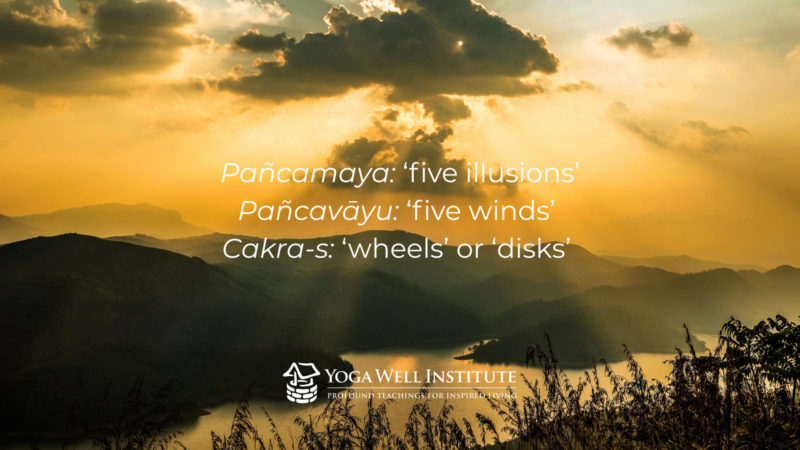The Yoga Well Insitute’s Yoga Therapist Training Program educates from both Eastern and Western perspectives. The Eastern tradition of Yoga practices and principles (along with its complementary ancient Indian perspectives, such as Āyurveda) combined with Western medical backgrounds, ensures a comprehensive perspective of health and healing. It also ensures our scope of practice as practitioners of an Eastern philosophical tradition while working within a Western context.
Yoga’s Eastern Roots

Yoga is an Eastern philosophy. It is born out of the Vedas; veda translates to ‘knowledge’ and the Vedas are a large body of text that originated in ancient India. Yoga is a sister of Sāṁkhya philosophy (Indian philosophy) and of Vedanta. It was developed out of ancient Indian anatomical and physiological models including:
- Pañcamaya, translates to ‘five illusions’ and describes the interacting dynamics that describe who we are as a material being: physical body, functioning systems, mind, personality, and emotions. Changing the state of one of these influences them all. Yoga’s range of tools can be thought of as how effective they are at affecting different dynamics.
- Pañcavāyu, translates to ‘five winds’ and relates to the way prāṇa moves within the human system. The vāyus relate to different yogic tools and locations in the body. They are: prāṇa (upward moving), apāna (downward moving), udāna (expression), samāna (digestion), and vyāna (circulation).
- Cakra-s translates to ‘wheels’ or ‘disks.’ The number of cakra-s in the human system is different in different traditions. Viniyoga recognizes seven chakras along the suṣuṁnā nāḍī, or central energetic channel. The cakra model illustrates the interaction of energy lines within the system and, along with the concepts of mala and agni, presents a way to remove energetic blockage and impurities.
To have a full understanding of Yoga, we must also explore the perspective of Āyurvedic doṣas, functional systems, disease processes, and more. The how and why of Yoga’s perspectives and application of tools were conceived in this ancient Indian milieu. As practitioners of Yoga, for others and ourselves, it is imperative to have a strong foundation in this collective knowledge.
These tools and perspectives come to life in our Practice; we follow Yoga as a lifestyle, a perspective, and learn to apply it in our Western lives.
It is imperative to also study the Western medical perspective in Yoga Therapy training because our work happens within a Western context. In order to best serve our clients, we must understand Western perspectives of functional systems of the body, disease manifestations, medical terminology, common medications, comorbidities, as well as treatment processes and procedures. The true challenge is in having all of this information, Eastern and Western, while maintaining an appropriate scope of practice.
A Yogic Perspective
Yoga Therapy strives to look at and concurrently serve the whole person: body, functioning systems, mind, personality, and emotions. Our true education is in how to see from a Yogic perspective: to understand how to treat symptoms that we may understand as having causes from different areas of personal development – not just physical, but the person as interdependent elements of a dynamic whole being.
Yoga Therapy tools were designed from a rich ancient Indian anatomical, physiological, and spiritual perspective. To apply these tools otherwise misses the complex beauty of how and why they work. It can also be a dangerous misappropriation of an ancient Eastern tradition.
As Yoga Therapists, we learn to maintain our scope of practice within an Eastern perspective of Yoga while being able to function in concert with Western medicine and other alternative modalities.

Meg Bratt
C-IAYT
In 2012, I completed a 500-hour Krishnamacharya lineage training (Viniyoga) with the Healing Yoga Foundation in San Francisco and continued with three-year training in Yoga Therapy with Yoga as Therapy North America (2017). I have been involved in creating, leading, and lecturing in teacher training programs since 2006.




